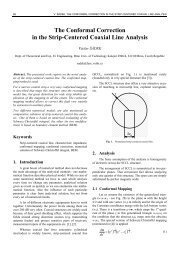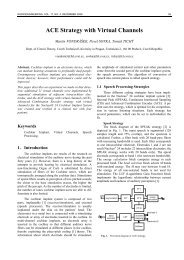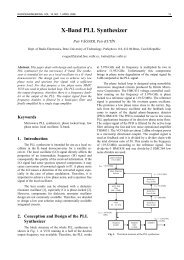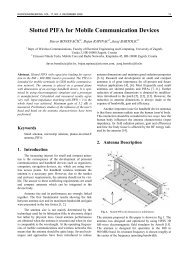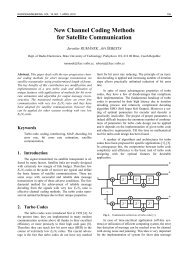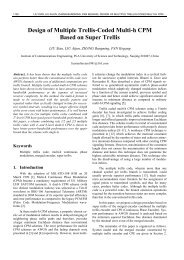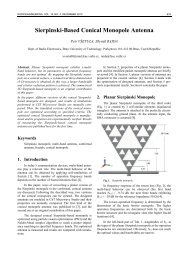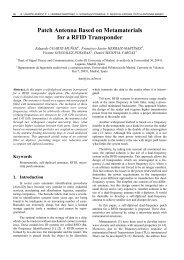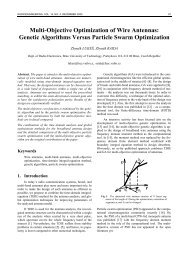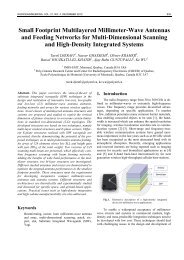210 H. HENNIGER, O. WILFERT, AN INTRODUCTION TO FREE-SPACE OPTICAL COMMUNICATIONS lowing link parameter: C 2 n(ha = const.) = 1 · 10 −14 m −2/3 , λ = 1550 nm, Θ = 1 mrad, D = 5 cm, pB = 10 −2 , PT x = 500 mW, Asystem,lin = 0.5, Ae = 0.2 dB/km, and a typical receiver sensitivity for a 155 Mbit/s system of Sr = −43 dBm. Fig. 6 shows the link margins according <strong>to</strong> (9) and (30). As described earlier, with increasing link length the integrated amount of turbulence increases. This first causes the scintillation-index <strong>to</strong> increase steadily, then a maximum is observed and finally it saturates. As shown in the lower plot in Fig. 6, the fading-loss according <strong>to</strong> (29) behaves in a way analogous <strong>to</strong> the scintillation-index. It first increases, peaks, and is than nearly constant for longer distances. Fig. 7. Upper plot: Link margin including the effect of fading cause by IRT in comparison <strong>to</strong> a case without atmospheric fading. Lower plot: Scintillation-index and fading-loss versus link distance in comparison <strong>to</strong> the link margin of the upper plot. If the basic parameters of the given link are known, it is possible <strong>to</strong> use (5) and obtain link margin Mlink as a function of link propagation distance L. Such a relationship represents the steady state model of the given link. In addition, if the statistical character of the atmosphere at the chosen installation site of the link is known, it is possible <strong>to</strong> obtain the probability of atmospheric attenuation exceeding a given value that represents the statistical model of the chosen link installation site. With the help of synthesis of the steady state model of a given link and the statistical model of the chosen installation site we can obtain the so-called complex model of the link. Statistical characteristics of the atmosphere in some localities in Europe were published in [11]. 3.4 Conclusion A brief survey of the fundamentals of FSO has been presented in this introduc<strong>to</strong>ry article. This brief survey has focused on outdoor FSO static optical links and describes some basic models of the link and some simple models of the atmosphere. The advantages of FSO result from the basic characteristics of a laser beam, especially from its high frequency, coherency and low divergence, which lead <strong>to</strong> efficient deliv- ery of power <strong>to</strong> a receiver and a high information-carrying capacity. The basic characteristics of a laser beam provide the following additional advantages of FSO links: • A narrow beam guarantees high spatial selectivity so there is no interference with other links. • The high available bit rate allows them <strong>to</strong> be applied in all types of networks. • The optical band lies outside the area of telecommunication regulation; therefore no license is needed for operation. • The small size and small weight of optical terminals enables links <strong>to</strong> be easily integrated in<strong>to</strong> mobile systems. Nevertheless, challenges remain. The main problems of FSO links working outdoors in the atmosphere result from attenuation and fluctuation of optical signal at a receiver. To improve reliability, a number of new methods are being applied. For example, a hybrid FSO/RF system increases link availability by overcomming attenuation effects. RF transmission is affected more by rain and optical transmission is affected more by fog. Further, error protection schemes able <strong>to</strong> deal with the slow fading typical for FSO links are currently under development. After considering all its advantages and disadvantages it is clear that FSO has good prospects for widespread implementation. FSO technology is ready for utilization as terrestrial links, mobile links and satellite links. Acknowledgements The authors would like <strong>to</strong> thank Professor Chris<strong>to</strong>pher C. Davis (University of Maryland) for his help and fruitful discussions. The research leading <strong>to</strong> these results has received funding from the European Community’s Seventh Framework Programme (FP7/2007-2013) under grant agreement no. 230126 and from the Research programs of the Czech Science Foundation No. 102/09/0550. References [1] DAS, S., HENNIGER, H., EPPLE, B., MOORE, C., RABINOVICH, W., SOVA, R., YOUNG, D. Requirements and challenges for tactical free-<strong>space</strong> lasercomm. In IEEE Military Communications Conference . San Diego (USA), 2008, p. 1 – 10. [2] WILLEBRAND, H., GHUMAN, B. Fiber optics without fiber. IEEE Spectrum, 2001, vol. 38, no. 8, p. 40 – 45. [3] PAUER, M., WINTER, P., LEEB, W. Bit error probability reduction in direct detection optical receivers using rz coding. Journal of Lightwave Technology, 2001, vol. 19, no. 9, p. 1255 – 1262.
RADIOENGINEERING, VOL. 19, NO. 2, JUNE 2010 211 [4] LEEB, W., WINTER, P., PAUER, M. The potential of return-<strong>to</strong>-zero coding in optically amplified lasercom systems. In IEEE Lasers and Electro-Optics Society 1999 12th <strong>An</strong>nual Meeting LEOS ’99, vol. 1. San Francisco (USA), 1999, p. 224 – 225. [5] STREET, A., SAMARAS, K., OBRIEN, D., EDWARDS, D. Closed form expressions for baseline wander effects in wireless ir applications. Electronics Letters, 1997, vol. 33, no. 12, p. 1060 – 1062. [6] MAJUMDAR, A. K., RICKLIN, J. C. <strong>Free</strong>-Space Laser Communications Principles and Advances. Sew York (USA): Springer, 2008. [7] DAVID, F. Scintillation loss in free-<strong>space</strong> optic im/dd systems. In LASE 2004, vol. 5338. San Jose (USA), 2004. [8] LAMBERT, S. G., CASEY, W. L. Laser Communications in Space. Bos<strong>to</strong>n (USA): Artech House, 1995. [9] WILFERT , O., KOLKA, Z. Statistical model of free-<strong>space</strong> optical data link. Proceedings of SPIE, 2004, vol. 5550, p. 203 – 213. [Online] Available at: http://link.aip.org/link/?PSI/5550/203/1 [10] WILFERT, O., KOLKA, Z., NEMECEK, J., BIOLKOVA, V. Estimation of fso link availability in Central European localities. Proceedings of SPIE, 2006, vol. 6303, p. 63030R. [Online] Available at: http://link.aip.org/link/?PSI/6303/63030R/1 [11] KOLKA, Z., WILFERT, O., FISER, O. Achievable qualitative parameters of optical wireless links. Journal of Op<strong>to</strong>electronics and Advanced Materials, 2007, vol. 9, no. 8, p. 2419 – 2423. [12] KOLKA, Z., WILFERT, O., KVICALA, R., FISER, O. Complex model of terrestrial fso links. Proceedings of SPIE, 2007, vol. 6709, p. 67091J. [Online] Available at: http://link.aip.org/link/?PSI/6709/67091J/1 [13] KNEIZYS, F. X. Atmospheric Transmittance/Radiance [Microform]: Computer Code LOWTRAN 6. Bedford (USA): Hanscom AFB, 1983. [14] SMITH, F. G., ACCETTA, J. S., SHUMAKER, D. L. The Infrared & Electro-<strong>Optical</strong> Systems Handbook. Atmospheric Propagation of Radiation, Vol. 2. SPIE Press, 1993. [Online] Available at: http://www.scribd.com/doc/13650098/IR-Handbook-Volume-2 [15] EDWARDS, D. P. GENLN2: A General Line-by-Line Atmospheric Transmittance and Radiance Model. Version 3.0: Description and users guide (technical report). National Center for Atmospheric Research, 1992. [16] MAYER, B., SHABDANOV, S., GIGGENBACH, D. Atmospheric Database of Atmospheric Absorption Coefficients (technical report). German Aero<strong>space</strong> Center (DLR), 2002. [17] MAYER, B., KYLLING, A. Technical note: The libradtran software package for radiative transfer calculations - description and examples of use.’ Atmospheric Chemistry and Physics, 2005, vol. 5, no. 7, p. 1855 – 1877. [Online] Available at: http://www.atmoschem-phys.net/5/1855/2005/ [18] HENNIGER, H., GIGGENBACH, D., RAPP, C. Evaluation of optical up- and downlinks from high-altitude platforms using im/dd. In LASE 2005, <strong>Free</strong>-Space Laser Communications Technologies XVII. San Jose (USA), 2005. [19] KRUSE, P. W., MCGLAUCHLIN, L. D., MCQUISTAN, R. B. Elements of Infrared Technology: Generation, Transmission and Detection. New York: Wiley, 1962. [20] P.1814: Prediction Methods Required for the Design of Terrestrial <strong>Free</strong>-Space <strong>Optical</strong> Links ITU-R WP3M (technical report). International Telecommunication Union, 2007. [21] KIM, I. I., MCARTHUR, B., KOREVAAR, E. J. Comparison of laser beam propagation at 785 nm and 1550 nm in fog and haze for optical wireless communications. Proceedings of SPIE, 2001, vol. 4214, p. 26 – 37. [Online] Available at: http://link.aip.org/link/?PSI/4214/26/1 [22] NABOULSI, M. A., SIZUN, H., DE FORNEL, F. Fog attenuation prediction for optical and infrared waves. <strong>Optical</strong> Engineering, 2004, vol. 43, no. 2, p. 319 – 329. [Online]. Available at: http://link.aip.org/link/?JOE/43/319/1 [23] ANDREWS, L. C., PHILLIPS, R. L. Laser Beam Propagation through Random Media. SPIE Press, 1998. [24] KARP, S., GAGLIARDI, R. M., MAORAN, M. S., STOTTS, L. B. (Eds.) <strong>Optical</strong> Channels: Fibers, Clouds, Water, and the Atmosphere. Plenum Press, 1988. [25] ANDREWS, L. C. Field Guide <strong>to</strong> Atmospheric Optics. SPIE, 2004. [26] GIGGENBACH, D., HENNIGER, H., DAVID, F. Long-term nearground optical scintillation measurements. In LASE 2003. San Jose (USA), 2003. [Online] Available at: http://elib.dlr.de/7260/ [27] WEISS-WRANA, K. R. Turbulence statistics in lit<strong>to</strong>ral area. Proceedings of SPIE, 2006, vol. 6364, p. 63640F. [Online] Available at: http://link.aip.org/link/?PSI/6364/63640F/1 [28] GIGGENBACH, D., HENNIGER, H. Fading-loss assessment in atmospheric free-<strong>space</strong> optical communication links with on-off keying. <strong>Optical</strong> Engineering, 2008, vol. 47, no. 4, p. 046001-1 – 046001- 6. [Online] Available at: http://elib.dlr.de/54181 [29] ANDREWS, L. C., PHILLIPS, R. L., HOPEN, C. Y. Laser Beam Scintillation with Applications. SPIE <strong>Optical</strong> Engineering Press, 2001. [30] YURA, H. T., MCKINLEY, W. G. <strong>Optical</strong> scintillation statistics for ir ground-<strong>to</strong>-<strong>space</strong> laser communication systems. Applied Optics, 1983, vol. 22, no. 21, p. 3353 – 3358, 1983. [Online] Available at: http://ao.osa.org/abstract.cfm?URI=ao-22-21-3353 [31] VETELINO, F. S., YOUNG, C., ANDREWS, L. Fade statistics and aperture averaging for gaussian beam waves in moderate-<strong>to</strong>strong turbulence. Applied Optics, 2007, vol. 46, no. 18, p. 3780 – 3789. [Online] Available: http://ao.osa.org/abstract.cfm?URI=ao- 46-18-3780 [32] EPPLE, B. A simplified channel model for simulation of free-<strong>space</strong> optical communications. Journal of <strong>Optical</strong> Communications and Networking, 2010, vol. 2, no. 5, p. 293 – 304. [33] HENNIGER, H., EPPLE, B., HAAN, H. Maritime mobile opticalpropagation channel measurements. In Proceedings of IEEE International Conference on Communications 2010. Cape Town (South Africa), 2010 (in press). [34] AL-HABASH, M., ANDREWS, L., PHILLIPS, R. Mathematical model for the irradiance probability density function of a laser beam propagating through turbulent media. <strong>Optical</strong> Engineering, 2001, vol. 40, p. 1554 – 1562. [35] ANDREWS, L. C., PHILLIPS, R. L., HOPEN, C. Y., AL-HABASH, M. A. Theory of optical scintillation. Journal of the <strong>Optical</strong> Society of America A, 1999, vol. 16, no. 6, p. 1417 – 1429, 1999. [Online] Available at: http://josaa.osa.org/abstract.cfm?URI=josaa-16-6-1417 [36] SANDALIDIS, H., TSIFTSIS, T. Outage probability and ergodic capacity of free-<strong>space</strong> optical links over strong turbulence. Electronics Letters, 2008, vol. 44, no. 1, p. 46 – 47. [37] KIASALEH, K. Performance of coherent dpsk free-<strong>space</strong> optical communication systems in k-distributed turbulence. IEEE Transactions on Communications, 2006, vol. 54, no. 4, p. 604 – 607. [38] HENNIGER, H., EPPLE, B. Technical Note: <strong>Optical</strong> Link Budget Tool (olibut) (technical report). Codex GmbH & Co. KG, 2007.
- Page 1 and 2: RADIOENGINEERING, VOL. 19, NO. 2, J
- Page 3 and 4: RADIOENGINEERING, VOL. 19, NO. 2, J
- Page 5 and 6: RADIOENGINEERING, VOL. 19, NO. 2, J
- Page 7: RADIOENGINEERING, VOL. 19, NO. 2, J



